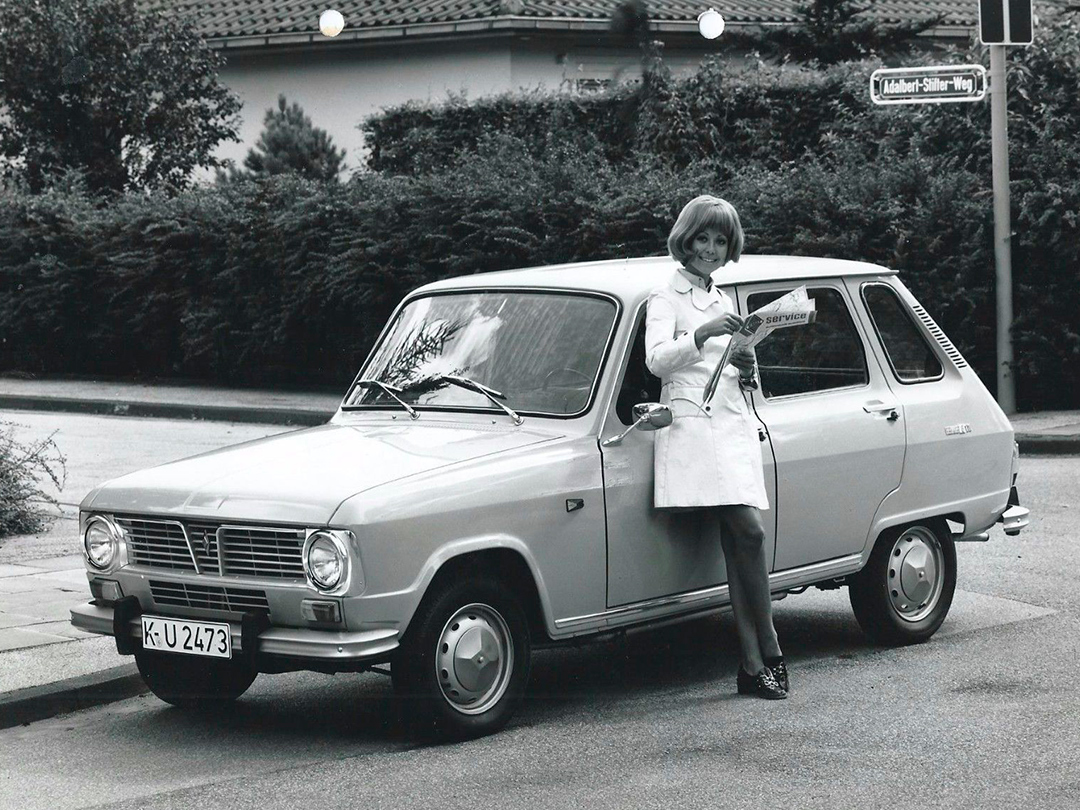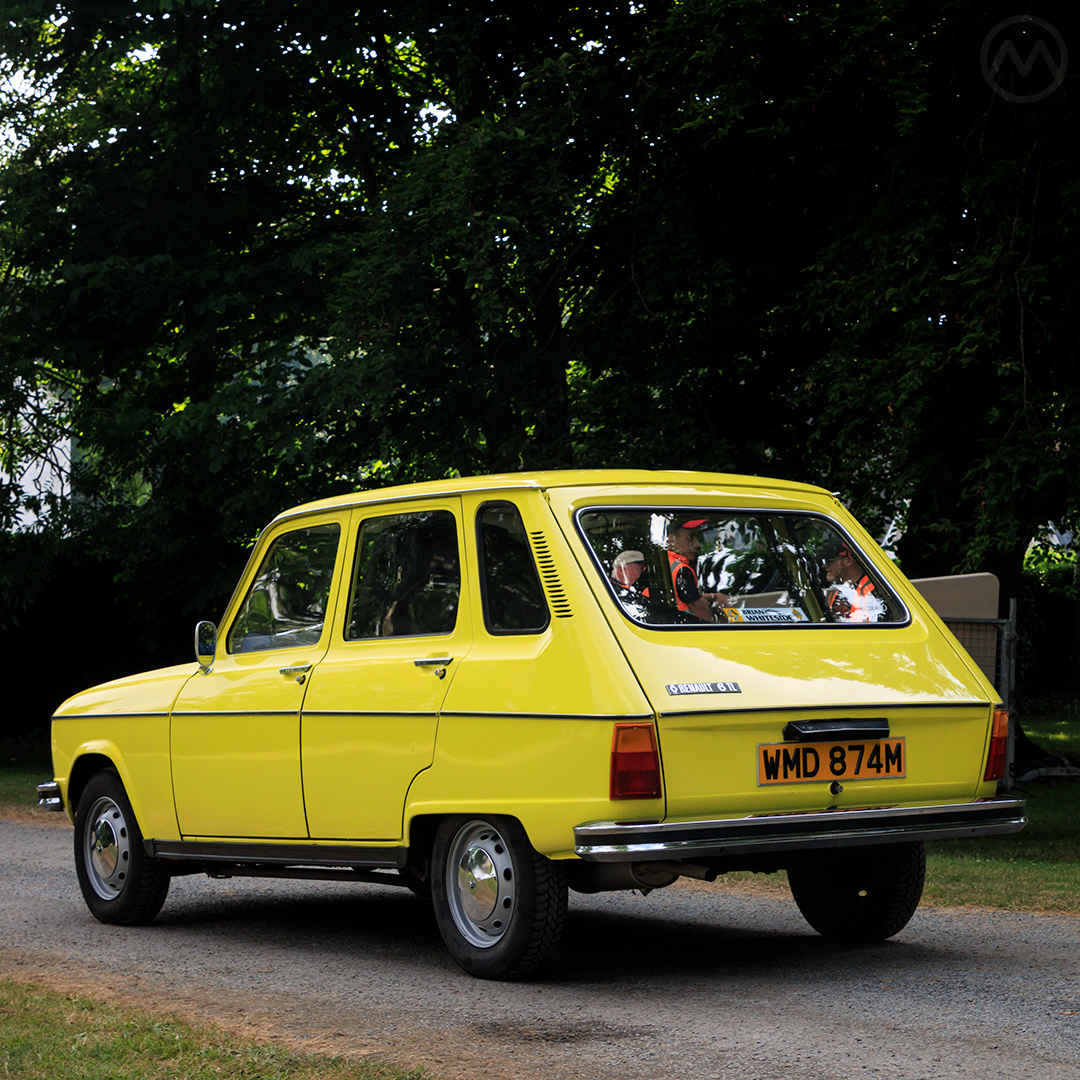It’s almost forgotten today, but the Renault R6 was a staple of 1970s European motoring and very common all over the U.K., Ireland, and Western Europe well into the 1990s. More than 1.5 million were made, and more than 2 million if you include local production in Spain, Argentina, and Colombia. It was practical, plebeian, and cheap, but for those same reasons, it’s exactly the kind of car that few people preserve. Today you hardly ever see them, let alone see ones this clean.
If it were launched now, Renault would probably call it a “crossover” thanks to its tall hatchback shape, and to be honest, it’s a whole lot more interesting than the modern-day Captur, but that’s another story. The R6 was designed to be practical and forward-thinking in more ways than one, but it took a while for the final recipe to coalesce.
Our yellow feature car is from 1974, and it’s pretty much peak R6 (also just called “Renault 6”), as the car was hardly changed at all from 1973 until the end of French production in late 1979, but the story starts much earlier, in 1964-65.
At that time, the front-wheel drive R4 and rear-engine R8 had mostly replaced the aging Dauphine, which the R6 would belatedly replace. But La Régie Nationale (Renault was a state-owned company then, and its full name was Régie Nationale des Usines Renault) felt that it needed another model between those two newer cars to fight off the Citroën Ami 6, despite the fact that the Ami 6 was only a 602-cc car and not much of a threat to the circa-1962 R8. Renault was, however, aware that Citroën and Simca were working on newer front-drive designs.
But it was more than that. Despite having one more rear-engine model in the pipeline, the 1965 R10, Renault felt that the days of rear-engine family sedans were numbered. It had already had a huge success with the R4 and was deeply invested in the R16, which debuted in the spring of 1965. With many competitors working away on front-drive designs, this was clearly the future, so the R6 would be the company’s third front-drive car.
To create it, they recycled and enlarged the R4’s platform, including its asymmetrical wheelbase, 96.5” (245cm) on the right & 94.5” (240 cm) on the left. This was pretty much the same practice applied to create the R16, but since that car was so much larger, it was more of a clean-sheet design along the same ideas, while the R6 was more of a literal enlargement of the R4 idea.

The styling, which may or may not have been done by Michel Boué working under Gaston Juchet, was a riff on the well-liked, much larger R16. In the planning stages, there were truck, van, & 4WD variant sketches, many done by Boué, who went on to stardom as the author of the R5, plus a very Simca-1100-like alternate hatch proposal. The design has never been entirely attributed to one person, and very few such designs are ever just one guy making it happen, although Boué later became a superstar as the “one guy” behind the original R5.
In the end, the R6 came out looking very R16-like and debuted at the 1968 Paris show. Renault had correctly gauged that people would be looking for small, efficient front-drive hatchbacks, a type that would later dominate European streets, but it did make a mistake with the initial R6, and early reviews weren’t great. In hopes of reducing motorists’ tax bills, the engineers had kept the R4’s 34-hp 845-cc four. The R6 was only a little larger and heavier, but it was enough weight to overmatch the little engine, which just didn’t have enough power to move the car with any authority.
In 1970, Renault more than fixed the problem by fitting the R8’s 44-hp 1108-cc “Cléon-Fonte” four along with front disc brakes, a better cooling system, and a new gearbox, though it kept the dash-mounted gear lever inherited from the “push-pull-twist” R4. Sales soared, but then the car’s evolution essentially stopped. Aside from a big facelift in 1973 and a smaller one in 1978, Renault just kept on selling it as was until French production ended in late 1979.
It looks pretty conservative today, but at the time, Renault had found a very good balance between offering the kind of technology associated with “too weird” Citroëns and visuals a little spicier than “too stuffy” Peugeots. Plus, the car was just very good. It was reliable and simple to maintain, it got 40 mpg, and it had a huge load area thanks to the big hatch, tall roof, and folding rear seats. (All things that sound very crossover-like when you type them out.)
Outside of France, the car was mass-produced in Argentina, Belgium, Colombia, and Spain. Belgian and Colombian R6s were not so different from the French versions, but the other two countries had some distinct differences. Argentinians got a 60-horsepower 1.4-liter version, which must have felt very quick compared to the European market ones, but Renault never offered such an engine in Europe, possibly because it might have cut into sales of the R12. Spanish cars got a 50-hp 956-cc Cléon-Fonte, under a liter for tax reasons, which was later shared with the Spanish-market R5 and R7.

With the R12 introduced in 1969, there wasn’t much room to grow the R6 lineup upward, and the design was limited to what had been baked in from the start. It sold very well even if it gradually got one-upped by newer designs like the Simca 1100 and eventually, other designs like the VW Golf, to which it responded with the larger, ultra-modern R14 in 1976.
But the R6, like the R4 and R16, was such a reliable seller that there was really no reason to kill it off, and it built enough of them at the end to keep selling the car for a few months into 1980 despite production having already ended. It was not exciting, and in fact, one British Journalist referred to it as “the sort of car people not interested in cars drive,” but it worked. That’s all most consumers ever want, just ask millions of Toyota Corolla fans.
The box van, pickup, and off-road R6s never emerged as depicted in Boué’s sketches, but an off-road R6 did happen, the Teilhol/ACL-built R6 Rodéo. This Citroën-Mehari like off-roader was usually front-wheel drive, but a few Sinpar 4WDs were made. The van version didn’t offer much that the very popular R4 Van didn’t already, which is probably why that one never got built, and without it, a truck version would’ve been cost-prohibitive from a production standpoint.
This amazingly clean 1974 R6 TL is easily the cleanest one I’ve ever seen. It’s a Northern Ireland car, but Renault was also selling very strongly in the Republic of Ireland at that time and would’ve been a very common sight.


Skoda da v IMV ju niso zaceli s proizvodnjo R6 kjer so vse pomanjkljivosti, ki so bile v R4 odpravili.